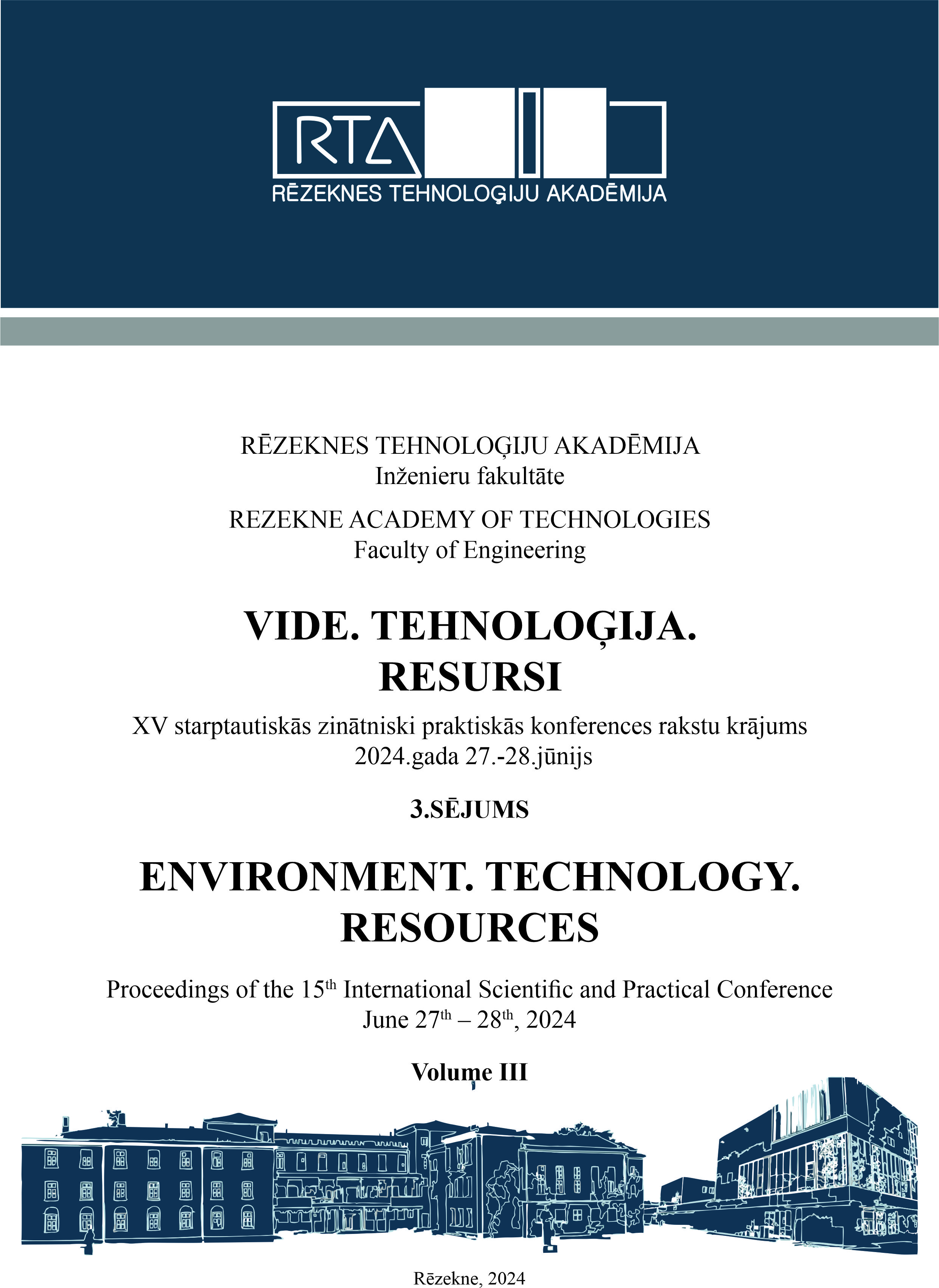METHODOLOGY AND MODEL FOR THE STUDY OF RELATIVE ACCURACY DEVIATION IN LASER CUTTING OF C 235 STEEL
DOI:
https://doi.org/10.17770/etr2024vol3.8171Keywords:
Laser cutting, laser cutting modes for C235 steel, modelling, multifactorial analysisAbstract
The paper presents an analysis using the design methodology based on the response of investigated quantities in the optimization of laser cutting parameters in terms of dimensional accuracy for C235 steel samples. The input factors, such as cutting speed, power, and carbon dioxide pressure, on the quality cut, expressed by the relative deviation from accuracy, are examined. The paper proposes an algorithm and a regression model to optimize the deviation from the dimensions between a model and a cut contour, by minimizing the error of this deviation. Based on the conducted experiment and research results, a generalized methodology was created. It can be used after a planned experiment to determine the accuracy of any contours of a test material of a specific thickness.
Downloads
References
L. Lazov, et.al., Numerical modeling and simulation for laser beam welding of ultrafine-grained aluminium, Laser Physics, 2021, 31(6), 6. 10.1088/1555-6611/abf5d3
L. Lazov, E. Teirumnieks, T. Karadzhov, N. Angelov, Influence of power density and frequency of the process of laser marking of steel products, Infrared Physics & Technology, 2021,Volume 116, 103783, https://doi.org/10.1016/j.infrared.2021.103783 .
H.A. Eltawahni, M. Hagino, K.Y. Benyounis, T. Inoue, A.G. Olabi, Effect of CO2 laser cutting process parameters on edge quality and operating cost of AISI316L, Optics & Laser Technology, Volume 44, Issue 4, 2012, pp. 1068-1082, ISSN 0030-3992, https://doi.org/10.1016/j.optlastec.2011.10.008 .
K. Huehnlein, K. Tschirpke, R. Hellmann, Optimization of laser cutting processes using design of experiments,Physics Procedia,Volume 5, Part B, 2010, pp. 243-252,ISSN 1875-3892, https://doi.org/10.1016/j.phpro.2010.08.050 .
A.K. Dubey, V. Yadava, Robust parameter design and multi-objective optimization of laser beam cutting for aluminium alloy sheet. Int J Adv Manuf Technol 38, 268–277 (2008), DOI 10.1007/s00170-007-1105-x.
Avanish Kumar Dubey, Vinod Yadava, Multi-objective optimisation of laser beam cutting process, Optics & Laser Technology, Volume 40, Issue 3, 2008, Pages 562-570, https://doi.org/10.1016/j.optlastec.2007.09.002 .
D. Kondayya, Gopala Krishna, A. An integrated evolutionary approach for modelling and optimization of laser beam cutting process. Int J Adv Manuf Technol 65, 259–274 (2013), DOI 10.1007/s00170-012-4165-5.
B. Adelmann, R. Hellmann, Fast Laser Cutting Optimization Algorithm, Physics Procedia, Volume 12, Part A, 2011, Pages 591-598, ISSN 1875-3892, https://doi.org/10.1016/j.phpro.2011.03.075 .
S. Genna, E.Menna, G.Rubino, V.Tagliaferri, Experimental Investigation of Industrial Laser Cutting: The Effect of the Material Selection and the Process Parameters on the Kerf Quality. Applied Sciences. 2020, 10(14):4956, https://doi.org/10.3390/app10144956 .
I.Vuchkov, L. Boyadjieva, Quality Improvement with Design of Experiments. A Response Surface Approach, 2001, https://link.springer.com/book/10.1007/978-94-009-0009-7 .
N.Tontchev, 2014. Materials Science, Effective Solutions and Technological Variants. 1st ed. LAP LAMBERT Academic Publishing. https://www.perlego.com/book/3343664/materials-science-effective-solutions-and-technological-variants-numerical-approaches-to-identification-of-effective-solutions-pdf.
N.Tontchev, G. Gaydarov, N. Hristov, "Analyses and applications using the computational approach “DEFMOT”, Sofia, 2022, 167 р. (in Bulgarian)
Л. Бузов, Миневски, И., Морфологичен модел на опасностите в ковашко-пресовото производство, Четвърта научна конференция – „Пожарна и аварийна безопасност”, МВР-Академия гр.София -2007, с. 108-110, ISBN 978-954-348-012-8
L. Lazov, et al., Modification of the roughness of 304 stainless steel by laser surface texturing (LST), Laser Physics, 2023, Volume 33, Number 4, DOI:10.1088/1555-6611/acbb76
R. S. Ghalot, L. Lazov, et al., Investigation of the Change in Roughness and Microhardness during Laser Surface Texturing of Copper Samples by Changing the Process Parameters, 2023, Coatings, 13(11):1970, DOI:10.3390/coatings13111970
L. Lazov, et.al., Numerical modeling and simulation for laser beam welding of ultrafine-grained aluminium, Laser Physics, 2021, 31(6), 6. doi:101088/1555-6611/abf5d3
L. Lazov, N. Petrov, Investigation of the Impact of the Number of Repetitions and the Defocus on the Contrast of Laser Marking for Products Made of Tool Steel, METALLOFIZIKA I NOVEISHIE TEKHNOLOGII, 2012, 34(7):1003-1011
I. Balchev, L. Lazov, et al., Investigation of the influence of the scanning speed and step in laser marking and engraving of aluminum, 2021, J. Phys., Conf. Ser., 1859 012002, DOI: 10.1088/1742-6596/1859/1/012002
Downloads
Published
Issue
Section
License
Copyright (c) 2024 Nikolay Tonchev, Victor Georgiev, Nikolay Dolchinkov, Nikolay Padarev, Emil Yankov

This work is licensed under a Creative Commons Attribution 4.0 International License.



